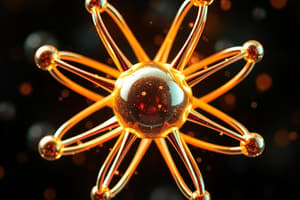Podcast
Questions and Answers
Who is credited with being the first to investigate the origin of matter?
Who is credited with being the first to investigate the origin of matter?
- A Medieval Scientist
- Thales of Miletus (correct)
- John Dalton
- A Greek Philosopher
What are the four elements of matter according to ancient Greek philosophy?
What are the four elements of matter according to ancient Greek philosophy?
- Matter, Energy, Space, and Time
- Earth, Air, Fire, and Water
- Solid, Liquid, Gas, and Plasma
- Earth, Air, Fire, and Wind (correct)
What is the term for a solid that is held together by the same kind of force that holds liquids together?
What is the term for a solid that is held together by the same kind of force that holds liquids together?
- Ionic Solid
- Covalent Network Solid
- Metallic Solid
- Molecular Solid (correct)
What is the term for the ability of a liquid to resist external forces and maintain its shape?
What is the term for the ability of a liquid to resist external forces and maintain its shape?
What is the term for a solid with a three-dimensional crystal lattice structure?
What is the term for a solid with a three-dimensional crystal lattice structure?
What is the term for the attraction between molecules of a liquid and the container it is in?
What is the term for the attraction between molecules of a liquid and the container it is in?
What is the main characteristic of atoms that makes them indestructible?
What is the main characteristic of atoms that makes them indestructible?
What is the primary reason why molecular solids have a lower melting point compared to ionic solids?
What is the primary reason why molecular solids have a lower melting point compared to ionic solids?
What is the term that describes the slight concave shape of a liquid's surface?
What is the term that describes the slight concave shape of a liquid's surface?
What is the primary characteristic of amorphous solids that distinguishes them from crystalline solids?
What is the primary characteristic of amorphous solids that distinguishes them from crystalline solids?
What is the term that describes the ability of a liquid to flow and change shape easily?
What is the term that describes the ability of a liquid to flow and change shape easily?
What is the primary reason why ionic solids are stronger than molecular solids?
What is the primary reason why ionic solids are stronger than molecular solids?
Flashcards are hidden until you start studying
Study Notes
Scientists and Their Contributions
- John Dalton (September 6, 1766 - July 27, 1844) was a significant figure in the study of matter.
- Thales of Miletus (624 to 546 BCE) was the first to investigate the origin of matter.
Atoms and Molecules
- Matter is composed of tiny, invisible, and indestructible particles called atoms.
- Atoms are the building blocks of molecules, which are large numbers of very small particles.
Four Elements of Matter
- According to ancient philosophy, the four elements of matter are earth, air, fire, and wind.
Types of Solids
- Solid: strong and hard to break due to particles being held together.
- Molecular solids: held together by the same kind of force that holds liquids together, e.g., candle wax.
- Metallic solids: held by metallic bonds, ranging from soft to hard, e.g., hammer or gold.
- Ionic solids: stronger than molecular solids, with high melting points, and dissolving into liquids, e.g., salt.
- Covalent network solids: giant covalent substances held together, most of which do not melt, e.g., diamonds.
- Amorphous solids: derived from the Greek word "amorphous," meaning shapeless, with very small amounts of solid, e.g., glasses.
- Crystalline solids: three-dimensional structure called a crystal lattice.
Liquids
- Liquids have no defined shape due to the movement of particles causing their shape to change.
- Properties of liquids: easy to break apart, cannot hold their own shape.
Liquid Properties
- Cohesion and surface tension: surface tension of a liquid.
- Adhesion and cohesion: not attracted to one another, but attracted to hold particles that make up the container holding the liquid.
- Meniscus: a slight concave on the surface of most liquids.
- Capillary action: changes the color of the petals.
Studying That Suits You
Use AI to generate personalized quizzes and flashcards to suit your learning preferences.




